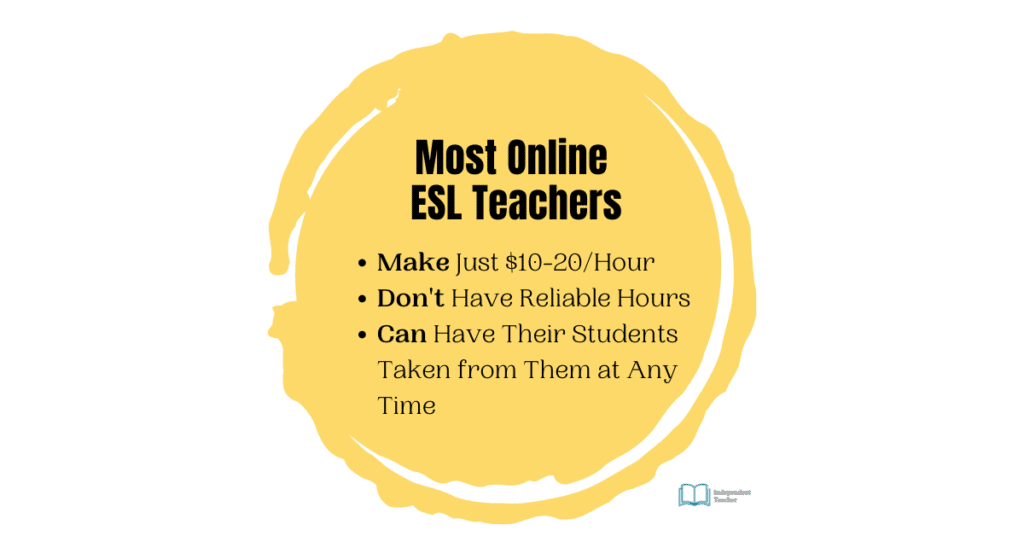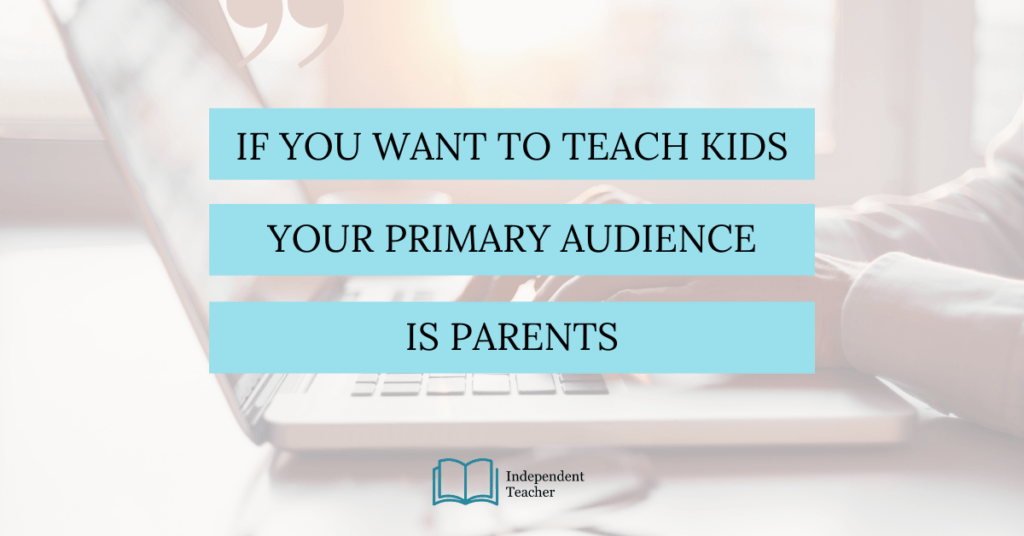
Most online ESL teachers:
- Have a company barrier between them and the families they serve
- Get paid very little for all the time they put into their preparation and teaching
- Don’t have reliable hours regardless of how much of a difference they make in their students’ lives
- Can have their connection with their students taken from them at any time
You can do better.
Remove the obstacles getting in the way of making a difference.
In this article, I’m going to tell you how.
They Are Out There
Before we go any further, you should know that what I’m going to recommend requires more work up-front.
But it will definitely be worth the effort.

In fact, if you follow through, in a year or two from now, you’ll be thanking yourself.
- You’ll be able to create long-lasting connections with students and their families.
- You’ll be able to charge a lot more for your time which makes your life more stable.
- You’ll no longer need to let a company take a big chunk of what you could earn.
You’re going to find your own students, students who love and appreciate you, students with whom you’ll be able to build lasting relationships, students with whom you’ll be able to have a bigger impact.
I will tell you how.
There are lots of students out there paying $40-100/hour for English lessons.
Many companies charge students these rates all of the time.
I should know.
I’ve worked with parents in Asia for over a decade at a successful school I built from the ground up.
- Parents pay $40-100/hour for programs all the time.
- Parents pay $10-30/hour for medium-large-sized group programs all of the time.
Your Primary Audience

They are out there, but you need to remember: If you want to teach K-12 kids, your most important audience when it comes to the success of your business is their parents.
Parents are the ones who will sign up their kids for your classes.
They need to understand why it is worth it and believe that you will get their children the results you promise.
You can connect with parents in many different ways online including social media, forums, and messaging apps.
You can also connect with the kids by creating engaging video content on a place like Youtube. Mark Rober is a great example of this, but he always has a note for the parents in there! (…learn how to think like an engineer! …hide the vegetables of learning!)
Mark Rober Example: Online Classes for Kids (But with Messaging for Parents)
(Pssst: If you need more help with finding your audience online, connecting with them, building a website, and creating a program, join the Independent Teachers Academy waiting list to be notified the next time enrollment opens and while you’re waiting, get started on this free course.)
You might be the best teacher in the world…
…but if the parents don’t see that—if the parents don’t trust you—they’re not going to sign their kids up for classes with you.
Parents generally trust teachers more than companies once they get to know them.
Companies benefit ENORMOUSLY from wonderful teachers like you only because they control the access to the parents.
Understanding Your Audience
First, if we’re going to connect with parents, we need to understand our parents better and be able to speak directly to their pains, fears, hopes & dream.
I’ve tested thousands of children and talked to thousands of parents.
Most parents are worried about similar things.
Parents are worried about:
- Whether their child is going to actually improve
- Whether the teacher is reliable.
- Wasting a bunch of time
- Teachers just teaching whatever they feel like on a particular day
- Knowing and seeing the progress of their kids
- Schools/Teachers telling them their students are doing fine but they don’t actually know for sure or are simply lying about it.
- Face to face practice with a native speaker
- Having benchmarks, seeing clear progress,
There is also a wide variety of needs and challenges they face.
Some common needs or hopes:
- Extra speaking practice for their children because they’re afraid they’re not getting enough practice at their after-school program.
- Help with passing particular tests
- To be able to speak English with their kids at home
- Middle school and high school students to keep learning/practicing even though they don’t have any time to attend a regular after-school program.
- To enjoy learning English and to NOT have to fight with their children about learning English, getting homework done, etc.
Mistakes ESL Teachers Make When Trying to Find Their Own K-12 Students

ESL teachers often struggle to find their own students and end up working for companies that take advantage of them due to a number of mistakes.
Mistake #1
Teachers forget that their primary audience is parents. Not kids. It’s important to make sure the kids make solid progress, to be sure. It’s important to do what’s best for the kids, to make sure the kids have a good time. But your ultimate success as an independent teacher involves connecting with the parents. Many ESL Teachers are great at talking to children, but haven’t yet mastered how to talk to their parents.
Mistake #2
Teachers often try to sell first and build relationships after. They throw up advertisements all over social media sending people to their sales pages, thinking they’ll build relationships with those people who sign up. That’s backward. You need to build relationships first, build trust first. You need to show your parents that you know what they need, what their students need.
Mistake #3
You need to sell the results your stellar program will get students, not just yourself. You need a solid program. You need a program with standards, goals, benchmarks. You need a program that promises specific results in a specific number of lessons. A program that goes beyond just the time you spend one-on-one with your kids by getting students to complete challenges, tasks, worksheets, etc outside of class time. If you need a curriculum like this, you can check out the Kid-Inspired ESL Curriculum Membership Pro.
Mistake #4
They offer themselves as a Jack of All Trades. Teachers do this to cast the net as wide as possible, but they end up ruining their chances at success at the same time. Think about how salesy it is when a used car salesman will say anything to make a sale. That’s the impression you give customers when you basically say I can teach anything to anyone at any time. You need to focus in on a particular aspect of English, a particular need, a particular age range. With time, you can create multiple programs for different needs. But by being generic, you end up being replaceable and coming off as untrustworthy.
Mistake #5
Teachers psyche themselves out by thinking parents’ options are either/or: either that company or me, as though it’s a choice between sending their students to an after-school program OR joining a program with you. Many parents feel like their kids don’t get enough conversation practice or are struggling with reading at an after-school program and would be very interested in a program that focused primarily on conversation or reading skills in addition to the after-school program they attend.
Mistake #6
They behave more like hourly-paid McDonald’s employees than highly-paid professionals. If you were a parent, would you want to let your kids take classes with a casually-dressed stranger who is offering cheap “English with Teacher John” or someone who…
- Dresses smartly and present herself or himself in a very organized way
- Has regular face-to-face meetings with parents
- Provides very specific benchmarked data on children’s progress
- Has a highly engaging and effective program developed based on parents’ and students’ specific needs
- Sends home detailed reports on student progress and does whatever it takes to help students in areas they may be struggling
- Charges one fee for a specific program that gets students specific results in a specific amount of time
What Should I Do?
Tip #1
Focus in on a specific group of parents of K-12 students.
Choose a specific age group, a specific need, a specific country, and possibly even a specific area or city of a country.
Get to know the parents’ needs of that specific group and be able to speak directly to the problems, challenges, or pain points those parents face. The more specific you go, the more you will be able to relate to those specific parents.
The more specifically you can describe the challenges and pressures parents of those students face, the more those parents will trust you to have a solution.
Tip #2
Many parents in Asia want K-5 kids in a classroom face to face with a teacher and less screen time. When their kids get to grades 6-12, they are just too busy and parents just want them to keep practicing and have someone to whom they can direct their questions and get help reviewing for tests.
You can still teach K-5, just consider offering more short-term programs or extra practice to help with a particular area that piggybacks on whatever classes they may already be taking.
Tip #3
Consider translating headlines of posts, or tips into the native language of the parents in your audience. Check out what the companies serving your audience are saying and posting on social media to parents.
You can use Google Translate or pay someone a few bucks on Fiverr.
Not everything needs to be in the native language, but seeing their native language will definitely catch their attention and make them feel like what you’re offering is specifically for them and not just some generic post.
Tip #4
Build an audience of those parents on social media by creating a group specifically for them.
Create an email list for them to sign up for tips, free lessons, resources, etc.
You need a lot more than one interaction with a parent before they come to know, like, and trust you and become willing to pay you for classes. Once they do come to know, like, and trust you, you’ll be able to charge a much more sustainable rate of $40-100/hour for your time.
Seek to serve, to help, before you ever offer any sort of program, course, or classes.
Tip #5
Interview the audience you start gathering. Find out what makes them tick. Find out what pain points they have. Find out what dreams they have.
Turn that into content that benefits your parents and helps them with their children’s English studies.
Do it because it’s helpful and do it for free.
Tip #6
The more closely you tie your program to the aspirations parents have for their children, the higher the rate you can charge.
If you speak to parents’ dreams to get their child into the right high school, the right college, if you can help their child pass the right test, or improve their grades at school, then make that your central message.
If you can help their child love learning English and/or improve in a particular skill or hobby, then tell them that right upfront.
Options to Consider:
- One-on-one tutoring with a specific program that includes benchmarks, feedback, tasks outside of class that get students results. (i.e. the Kid-Inspired ESL Curriculum can help you out with this! – See Below)
- A short-term program that focuses on using English in conjunction with a specific skill or hobby (i.e. Cooking, Chess, Minecraft Programming, Sketching, Painting, etc). These can be made extra-attractive by sending students materials, projects, rewards, etc. in the mail! (Not only can you charge more but you get more engagement.)
- A short-term program that focuses on a specific proficiency test (Cambridge, Oxford, YingJian, etc)
- Membership platform that includes resources, videos, community, group sessions around particular hobbies, skills, or interests that make learning English fun & interesting.
When you find parents and students of your own online and create something remarkable for them, you’ll be able to:
- Connect with them more closely
- Make a bigger impact on their lives
- Build life-long relationships with families
- Live a happier, more fulfilled life
It can take a little more work upfront, but it is totally worth it in the end.
You can find more resources below to help you get started.
Need More Help? Join the Free Course
I’ve put together a free course that you might find helpful called How to Build a Meaningful & Successful Online Teaching Business.


